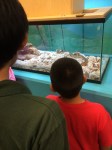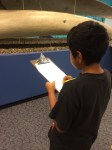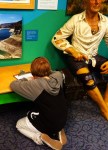The bus pulled up in front of the Reuben H. Fleet Science Center as the much-needed rain pelted down. Excited fifth graders poured from the bus into the rain, ready to explore.
And waiting just inside were a group of classroom teachers and museum educators ready to watch closely and think carefully about how these students’ teachers and chaperones support student learning and promote student inquiry during the field trip.
This was the pilot of the materials developed by the participants of the Intersections project–a collaboration between the San Diego Area Writing Project (SDAWP), the Reuben H. Fleet Science Center, and the San Diego Natural History Museum funded by a National Science Foundation Grant to the National Writing Project and the Association of Science and Technology Centers. This group of educators has been meeting and learning together–with a focus on inquiry, science, writing, and field trips since the fall. And just a week ago they designed “tools” for use to prepare for and facilitate the field trip to the two museums.
And the field trip was an opportunity to examine the tools in use, with the aim of improving them in a next iteration. We watched the kids in action, noting their conversation, their body language, their interaction with the exhibits…taking pictures, detailed field notes, video and audiotape…all with the goal of understanding their experience in order to improve students’ opportunities for learning and engagement. And…we were under strict orders to only observe–something very difficult for this group of hands-on educators dedicated to facilitating engaging learning experiences for students!
After lunch, students moved across the park plaza to the NAT and we repeated the process.
Students sketched and wrote, questioned and connected what they were seeing and learning to things they already knew.
And one of my favorite moments was at the end of the trip, just before the students headed back to board their bus for the ride back home. They had discovered the pendulum at the NAT and were curious about the little blocks set up inside the circle where the pendulum swung. Would the ball of the pendulum knock the blocks over? They started watching by learning on the rail…and then got lower…until they were laying on their bellies on the floor, feet bent up behind them, noses pushed up against the railing. And they watched, almost holding their breath as the ball closely avoided the tiny blocks. And then it happened. The block fell…and the cheer broke the quiet!
After the students left we took some time to reflect on our experience…and also hear the experience of the teachers in our group who brought these students to the museums. There were lots of things that went well…and plenty that we still want to improve. And plans are already being made for improved tools and new tools for our next field trip pilot…sometime in April.
There is something amazing about the opportunity for educators to collaborate, to design and then to test, to take time for careful, considered observation and data collection, and then time to reflect on their learning. If only there were more opportunities like this one, for educators to come together to make sure that students have optimal learning experiences…how would that change our world?























